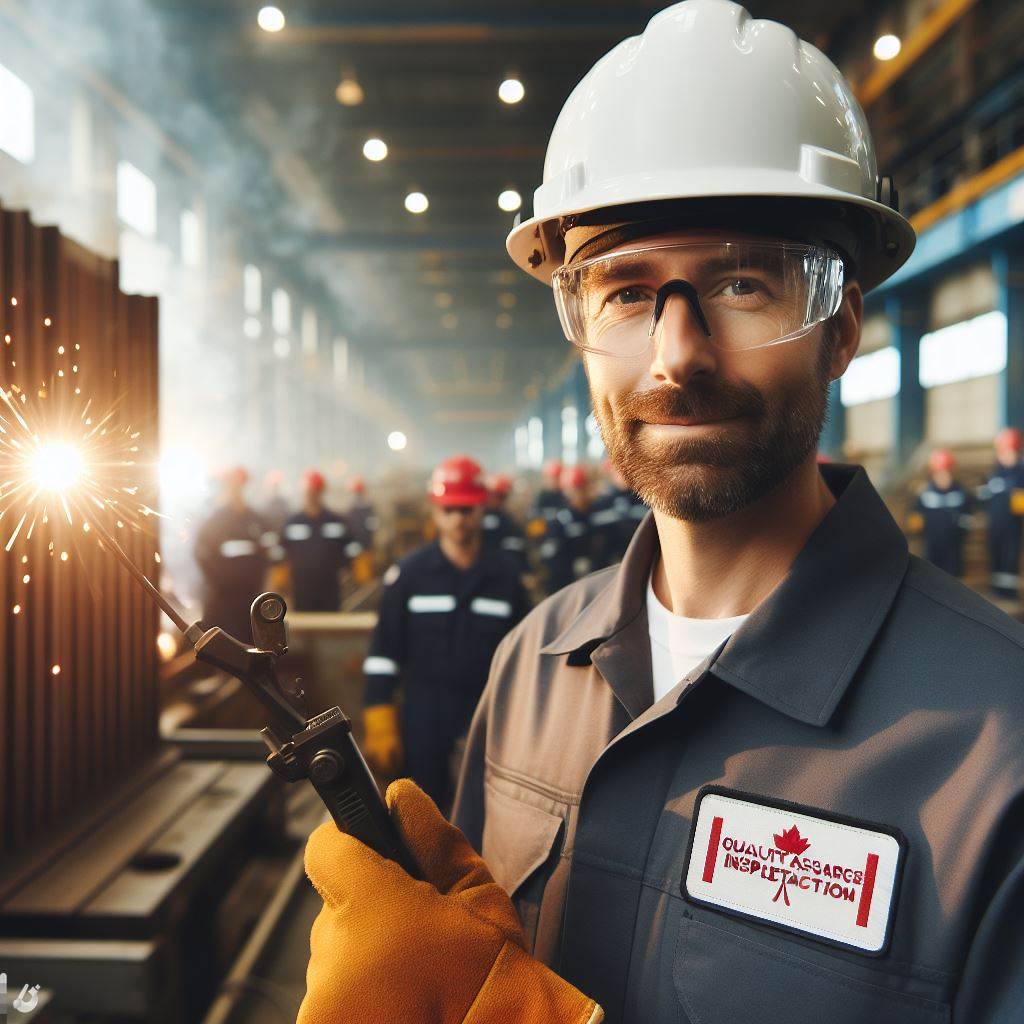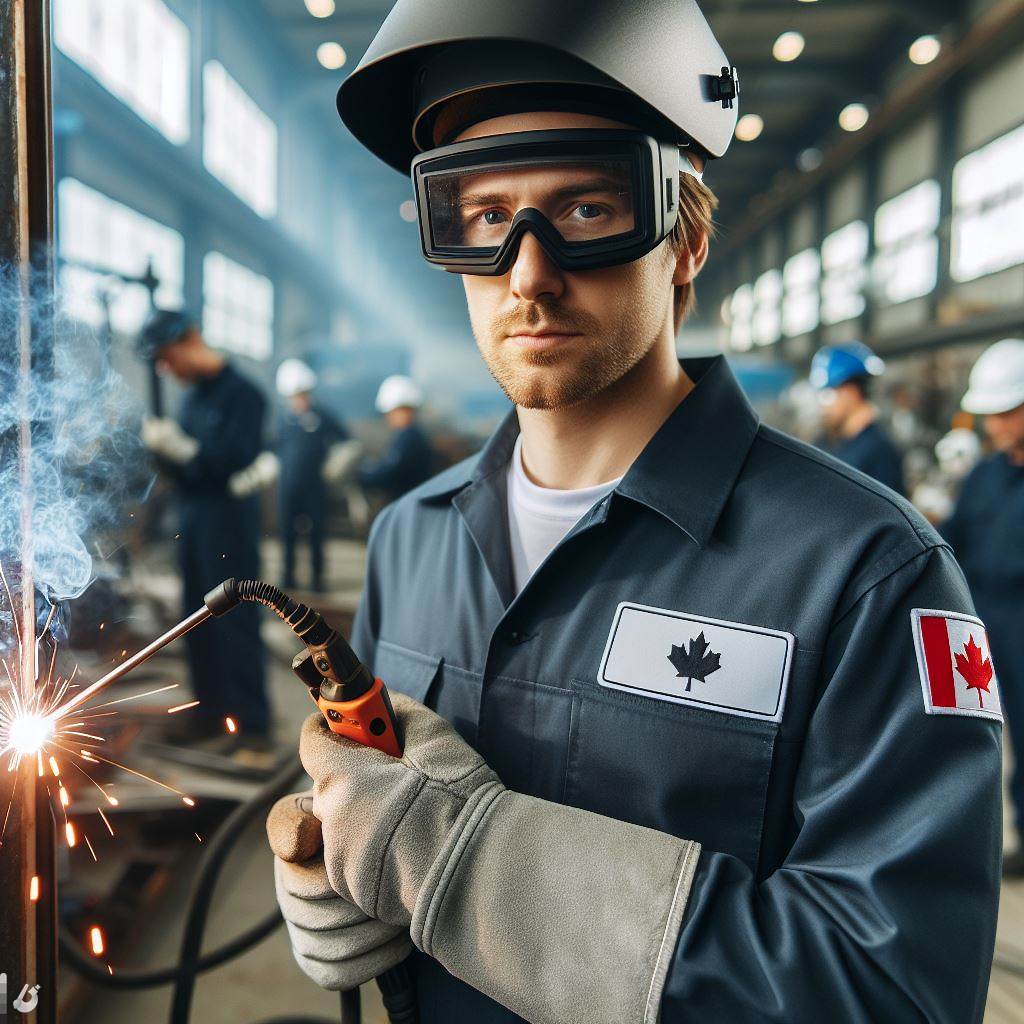Introduction
Welding is an essential process in the Canadian oil and gas sector, providing strength and durability to infrastructure.
This industry heavily relies on welded joints to connect pipelines, storage tanks, and other vital components, ensuring the smooth operation of the sector.
The performance and safety of these structures depend on the quality and precision of the welds.
The main objective of welding in the Canadian oil and gas sector is to create secure and leak-proof connections that can withstand extreme conditions, such as high pressure and harsh environments.
Welders utilize various techniques, including arc welding, gas metal arc welding (GMAW), and shielded metal arc welding (SMAW), to achieve high-quality welds with optimum strength and corrosion resistance.
Moreover, proper welding contributes to the longevity of infrastructure, minimizing the need for frequent repairs and replacements.
This leads to cost savings for companies operating in the oil and gas sector, as well as reduced downtime, ensuring uninterrupted production and supply of energy resources.
However, welding in this sector also presents unique challenges.
The presence of flammable materials and hazardous environments demands strict adherence to safety regulations and precautions.
Welders must be well-trained and equipped with knowledge on handling potentially dangerous situations.
In short, welding plays a critical role in the Canadian oil and gas sector, ensuring the structural integrity and safety of vital infrastructure.
This post will delve into the significance of welding within this industry, addressing key points related to techniques, safety measures, and the overall importance of this process.
Overview of the Canadian Oil and Gas Sector
Description of the sector’s importance to the Canadian economy
- The Canadian oil and gas sector plays a significant role in the country’s economy.
- It contributes to job creation, government revenues, and overall economic growth.
- Canada is one of the world’s largest producers and exporters of oil and gas.
- The sector attracts investments and drives innovation in related industries.
- It also provides energy security for the country and supports various sectors, including transportation and manufacturing.
Explanation of the different activities within the sector, including exploration, extraction, and refining
- Exploration: Companies search for new oil and gas deposits by conducting geological surveys and seismic studies.
- Extraction: Once a deposit is discovered, drilling operations are carried out to extract oil and gas from the ground.
- Refining: Raw materials undergo refining processes to produce usable products like gasoline, diesel, and petrochemicals.
- Transportation: Oil and gas are transported through pipelines, trucks, ships, or railways to various markets.
- Distribution: Refined products are distributed to end consumers through fuel stations, distributors, and industrial customers.
Statistics highlighting the contribution of the oil and gas sector to Canada’s GDP and employment
- In 2020, the oil and gas sector contributed approximately 10.6% to Canada’s GDP.
- It accounted for over 550,000 direct and indirect jobs in various occupations and skill levels.
- Oil and gas activities generated billions of dollars in government revenues through taxes, royalties, and other fees.
- The sector’s economic impact extends to supporting communities and financing public services across the country.
- It fosters technological advancements, research, and development, leading to spill-over benefits for other sectors.
In fact, the Canadian oil and gas sector is of great importance to the country’s economy.
It contributes significantly to GDP, employment, and government revenue.
With its diverse activities ranging from exploration to refining, the sector ensures energy security and drives innovation.
By understanding its significance, Canada can continue to optimize and sustainably develop its oil and gas resources.
Read: The Environmental Impact of Welding in Canada
Role of Welding in the Canadian Oil and Gas Sector
Welding serves as the backbone of the Canadian oil and gas sector, playing a critical role in all stages of operations.
From the construction of infrastructure to ongoing maintenance and repair, welding ensures the industry’s efficiency, safety, and profitability.
Definition and Explanation of Welding
In the oil and gas sector, welding is defined as the process of joining two or more materials, typically metals, by melting them together.
It requires the application of high heat and pressure to fuse the materials, creating a strong and durable bond.
This technique is essential in handling the demands of the industry, as it provides a reliable method for fabricating and repairing various components and structures.
Importance of Welding in Various Aspects of the Oil and Gas Sector
The importance of welding in the Canadian oil and gas sector cannot be overstated.
In construction, welding is used extensively to create pipelines, which form the lifeline of the industry.
These pipelines transport oil and gas over long distances, connecting production sites with distribution points.
Unlock Your Career Potential
Visualize a clear path to success with our tailored Career Consulting service. Personalized insights in just 1-3 days.
Get StartedPrecise and reliable welds are crucial to ensure the integrity and efficiency of these pipelines, as any leakage or failure could lead to significant environmental damage and financial losses.
Maintenance is another critical aspect where welding plays a vital role.
Regular inspections and maintenance of equipment, such as valves, pumps, and storage tanks, are necessary to prevent failures and ensure smooth operations.
Welding is used to repair and reinforce weakened or damaged components, ensuring they can continue to function reliably under extreme conditions.
Without welding, maintenance efforts would be challenging and costly, leading to potential downtime and safety hazards.
Examples of Specific Welding Applications in the Sector
Welding also finds specific applications in various sectors of the oil and gas industry.
Pipeline construction is a prime example, where welding is used to connect pipes of various sizes and materials.
These welds must meet stringent quality standards to guarantee the durability and safety of the pipeline infrastructure.
Storage tanks, another crucial element in the industry, require welding for both construction and maintenance.
Welded joints are used to assemble tank shells, while repairs and modifications often necessitate welding to maintain their structural integrity.
Refineries, the complex facilities responsible for processing crude oil into various products, heavily rely on welding.
From connecting pipes and vessels to repairing heat exchangers and boilers, welding plays a crucial role in ensuring continuous operations and preventing leaks or failures that could have disastrous consequences.
In essence, welding plays a pivotal role in the Canadian oil and gas sector. From construction to maintenance and repair, its importance cannot be understated.
Whether it’s pipeline construction, storage tank maintenance, or refinery operations, welding is essential to ensure the sector operates efficiently, safely, and sustainably.
Read: Safety Standards in Canada’s Construction
Welding Techniques and Technology in the Oil and Gas Sector
In the Canadian oil and gas sector, welding plays a crucial role in the construction, maintenance, and repair of various infrastructure and equipment.
Welding techniques and technology have evolved over the years to meet the industry’s demanding requirements.
Overview of Common Welding Techniques
Three commonly used welding techniques in the oil and gas sector are stick welding, MIG welding, and TIG welding.
These techniques are preferred due to their versatility and ability to withstand harsh environments.
Stick welding is also known as shielded metal arc welding (SMAW).
It involves the use of an electric current to create an arc between the welding electrode and the base material.
Stick welding is suitable for welding thick materials and is often used for pipeline construction and maintenance work.
MIG welding, or gas metal arc welding (GMAW), utilizes a consumable electrode wire that continuously feeds through a welding gun.
The electrode melts and forms a strong bond with the base material. MIG welding is widely used in the oil and gas sector for its high productivity and efficiency.
TIG welding, or gas tungsten arc welding (GTAW), uses a non-consumable tungsten electrode to produce the weld.
A separate filler metal may be used if required. TIG welding is known for its precision and ability to create high-quality welds, making it suitable for critical applications in the sector.
Description of Specialized Welding Processes
In addition to the common welding techniques, specialized welding processes are employed in the oil and gas sector to meet specific requirements.
Orbital welding is a highly automated process that utilizes a rotating weld head to perform precise and repetitive welds.
It ensures consistent quality and reduces the risk of human error.
Orbital welding is commonly used for joining pipes and tubes in the sector, especially in critical applications that demand high-quality welds.
Underwater welding is a unique process used for welding in underwater environments, primarily in offshore oil and gas structures.
Highly skilled divers equipped with specialized equipment perform underwater welding. This process is crucial for the construction and maintenance of subsea pipelines and structures.
Introduction to Advanced Welding Technologies and Equipment
With advancements in technology, the oil and gas sector has embraced various advanced welding technologies and equipment to enhance efficiency and precision.
Robotic welding systems have gained popularity in the sector due to their ability to perform repetitive welds with high accuracy.
These systems consist of robotic arms equipped with welding tools that can navigate complex geometries and execute welds with precision.
Robotic welding systems are widely used in the fabrication of offshore structures and equipment.
Other advanced welding technologies and equipment used in the sector include laser welding, friction stir welding, and plasma arc welding.
These advanced techniques offer advantages such as reduced heat input, increased welding speed, and improved weld quality.
In general, the Canadian oil and gas sector relies on a range of welding techniques and advanced technologies to meet the demanding requirements of construction, maintenance, and repair.
From stick welding to specialized processes like orbital and underwater welding, these techniques play a vital role in ensuring the integrity and safety of the sector’s infrastructure.
The adoption of advanced welding equipment, including robotic systems, further enhances efficiency and precision in welding operations.
Read: Electrician Salary Ranges in Canada’s Provinces

Welding Certifications and Qualifications for the Canadian Oil and Gas Sector
Importance of certification for welders working in the sector
- Certification is vital for welders in the Canadian oil and gas sector.
- It ensures that they meet the industry’s standards and safety requirements.
- Certified welders have proven their skills and knowledge through rigorous testing.
- Employers prefer certified welders as they are more reliable and competent.
- Having a certification enhances the welder’s employability and career prospects.
Overview of the different certification bodies in Canada, such as the Canadian Welding Bureau (CWB) and the American Welding Society (AWS)
- The Canadian Welding Bureau (CWB) is one of the most recognized certification bodies in Canada.
- CWB offers a wide range of welding certification programs tailored to various industry sectors.
- It ensures that welders meet specific code requirements for different materials and welding processes.
- The American Welding Society (AWS) also provides certifications that are recognized in Canada.
- AWS certifications are widely accepted globally and are considered valuable credentials for welders.
Explanation of the required qualifications and skills for welders in the oil and gas sector, including knowledge of specific codes and standards
- Welders in the Canadian oil and gas sector must possess specific qualifications and skills.
- They need to have a thorough understanding of welding codes and standards, such as CSA W59 and ASME Section IX.
- Knowledge of specific welding processes, such as shielded metal arc welding (SMAW) and gas metal arc welding (GMAW), is essential.
- Proficiency in reading and interpreting welding blueprints and technical drawings is crucial.
- Welders must have the ability to perform various welding techniques and produce high-quality welds.
- They must also possess good problem-solving skills and be able to troubleshoot welding issues.
- Safety awareness and adherence to safety protocols is of utmost importance.
- Welders should have excellent hand-eye coordination and manual dexterity.
- Physical stamina and the ability to work in challenging environments are necessary.
- Continuous learning and staying updated with the latest welding technologies and techniques is essential.
In brief, welding certifications play a significant role in the Canadian oil and gas sector.
They validate a welder’s skills and ensure compliance with industry standards.
The Canadian Welding Bureau (CWB) and the American Welding Society (AWS) are prominent certification bodies in Canada.
Welders in this sector require specific qualifications, knowledge of codes and standards, and proficiency in various welding processes.
Possessing these qualifications and skills enhances a welder’s employability and opens up opportunities for career advancement in the oil and gas industry.
Read: Electrician Certifications in Canada: A Guide
Employment Opportunities and Career Path for Welders in the Canadian Oil and Gas Sector
Discussion of the high demand for welders in the industry
The Canadian oil and gas sector has a constant and high demand for skilled welders.
With the industry’s growth and expansion, welders are indispensable assets in maintaining and constructing infrastructure.
Welding plays a crucial role in several key activities within the sector.
Essential for pipeline construction, fabricating oil rigs, maintaining drilling equipment, and repairing oil and gas refineries.
The demand primarily stems from the sector’s continuous need for infrastructure development and maintenance of existing facilities.
Welding, being a specialized skill, offers stable employment opportunities and a promising future for welders in this sector.
Overview of the potential career path starting from entry-level positions to becoming a certified welding inspector or supervisor
The career path for welders in the Canadian oil and gas sector is diverse and offers room for growth and specialization.
Welders typically begin as entry-level workers, primarily involved in assisting more experienced welders and performing basic welding tasks.
This stage allows them to develop fundamental skills and gain hands-on experience.
As they gain proficiency, welders can move up the ladder to become journeyperson welders.
At this level, they are responsible for welding complex components, interpreting blueprints, and ensuring the quality of welds.
With further experience and additional certifications, welders can specialize in specific areas such as pipeline welding, pressure vessel welding, or offshore welding.
They can also pursue roles in supervision, becoming welding inspectors or welding supervisors.
Becoming a certified welding inspector or supervisor requires acquiring additional qualifications, such as obtaining certification through the Canadian Welding Bureau (CWB) or the American Welding Society (AWS).
These certifications validate the welder’s expertise and qualify them to oversee welding operations, ensure compliance with industry standards and specifications, and provide quality control.
Examples of job titles and roles within the sector that can be pursued by welders
The Canadian oil and gas sector offers diverse job titles and roles that welders can pursue:
- Pipeline Welder: Specializes in welding pipelines and ensuring their structural integrity and quality.
- Oil Rig Welder: Engaged in the fabrication and maintenance of oil rigs, performing welding tasks in harsh offshore environments.
- Refinery Welder: Involved in the repair and maintenance of oil and gas refineries, ensuring their safe operation and structural integrity.
- Pressure Vessel Welder: Specializes in welding pressure vessels used in the oil and gas sector, adhering to strict safety and quality standards.
- Welding Inspector: Responsible for inspecting welding work, ensuring compliance with industry standards, and maintaining quality control.
- Welding Supervisor: Manages and supervises welding teams, coordinates welding operations, and ensures project timelines and quality standards are met.
These are just a few examples of the various job titles and roles available to welders in the Canadian oil and gas sector.
The sector provides ample opportunities for growth, specialization, and career advancement in the welding profession.
In summary, the Canadian oil and gas sector presents a wealth of employment opportunities for welders.
The high demand for skilled welders, along with the potential for career growth and specialization, makes it an attractive industry for those pursuing a welding career.
With the right skills, qualifications, and certifications, welders can establish a fulfilling and prosperous career in this sector.
Challenges and Future Trends in Welding for the Canadian Oil and Gas Sector
Identification of challenges faced by welders in the industry, such as harsh working conditions and safety concerns
Welders in the Canadian oil and gas sector face numerous challenges in their day-to-day work.
Known for demanding work environments, the sector entails extreme temperatures, high-pressure conditions, and exposure to hazardous substances.
These conditions can put welders at risk of physical injury, respiratory issues, and long-term health problems.
Welders in the industry encounter significant challenges, with safety concerns being a prominent issue.
The nature of their work inherently involves high-risk activities such as welding, cutting, and handling flammable materials.
Welders must constantly be vigilant about following safety protocols and wearing appropriate personal protective equipment (PPE) to minimize the risk of accidents and injuries.
The potential for accidents and their consequences underscores the importance of robust safety training programs and ongoing monitoring of safety practices.
Discussion of emerging trends and technologies in welding, such as laser welding and 3D metal printing
The welding industry is constantly evolving, with new trends and technologies emerging to improve efficiency, quality, and safety.
One such trend is the adoption of laser welding. Laser welding offers several advantages over traditional welding methods, including higher precision, faster production rates, and reduced heat-affected zones.
It is particularly useful for welding thin materials and can be automated to increase efficiency.
Another emerging technology in welding is 3D metal printing, also known as additive manufacturing.
This innovative technique allows for the creation of complex metal structures directly from digital models.
It offers great potential for reducing material waste, increasing design flexibility, and streamlining production processes.
While 3D metal printing is still in its early stages of adoption in the oil and gas sector, its potential applications are vast.
Consideration of potential impacts of renewable energy and carbon reduction initiatives on welding jobs in the sector
The growing focus on renewable energy and carbon reduction initiatives has the potential to impact welding jobs in the Canadian oil and gas sector.
As the world shifts towards cleaner energy sources, there may be a decrease in the demand for traditional fossil fuel extraction and processing.
This could result in a decline in welding jobs within the sector.
However, it is important to note that renewable energy infrastructure still requires skilled welders for construction, maintenance, and repair.
Additionally, welding skills can be transferable to other industries, such as green energy production and infrastructure development.
The shift towards renewable energy may present opportunities for welders to adapt and work in new sectors.
In a nutshell, welders in the Canadian oil and gas sector face various challenges related to harsh working conditions and safety concerns.
However, the industry is also witnessing the emergence of new trends and technologies in welding, such as laser welding and 3D metal printing, which can enhance productivity and quality.
The potential impacts of renewable energy and carbon reduction initiatives on welding jobs in the sector remain uncertain but may present opportunities for welders to diversify their skills and contribute to the development of clean energy infrastructure.
See Related Content: Navigating Construction Unions in Canada
Conclusion
Welding plays a crucial role in the Canadian oil and gas sector, ensuring the safety and integrity of infrastructure.
Throughout this blog post, we have discussed key points such as the demand for skilled welders and the importance of their training.
Looking ahead, the future prospects for welders in the industry are promising, with numerous opportunities for growth and advancement.




